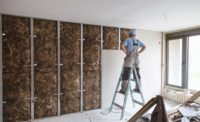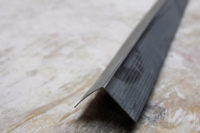I know there are some people in my area of work that still do plaster work, but I don’t personally know any. It was not long after I became established as a quality drywall finishing company that I started to get calls for plaster repairs and resurfacing. I live in Saratoga County, N.Y. where there are a lot of older homes that have lath and plaster walls and ceilings. The last thing the homeowners wanted was plaster replaced with drywall—and I agree. I have never liked the idea of covering old plaster with a layer of drywall, and I certainly didn’t want to remove all that dusty old plaster, especially with the lead paint laws enforced today. So, plaster repairs and resurfacing was the only viable answer.
At first I tried applying basecoat and finish coat plaster and became quite good at this. It is interesting that not long after I purchased a couple bags of plaster from my supplier that I started getting more calls for plaster work. But I was looking for something easier and less expensive that I could offer my customers. After all, we were a drywall finishing company, not a plastering company.
I actually was out in the warehouse of the company that makes FibaFuse drywall tape about five years ago. We were shooting a how-to video on the drywall tape when I noticed a 3-foot-wide roll of the product. I don’t know why it was there but I grabbed the roll and troweled some compound on a wall and easily embedded the material. The Fibafuse material is a fiberglass matt—not a weave—and because the fibers are not particularly dense, it is quite porous. It is very easy to embed in joint compound, which is the adhesive that holds the material in place.
A lot of the old plaster has surface cracks over much of the surface, and it is very time consuming to apply tape over each crack, even when using self-adhesive mesh tape. Then, all these taped areas have to be concealed with multiple layers of compound. This is before the spider cracks are even considered. Spider cracks are what I call the fine cracks that are sometimes all over the surface. These spider cracks appear to just be cracks in the paint surface, but I was never sure what to do about them. Was it necessary to reinforce each of these cracks? Reinforcing all these cracks was difficult and time consuming. This process required a lot of mesh tape and was a slow process.
I started using the FibaFuse Wall Reinforcement because I can now cover the entire surface and it is simply embedded in joint compound. The surface becomes quite smooth during the embedding process. This is not true when taping and patching. I did try the wide roll of self-adhesive mesh and had good results but I actually prefer the fiberglass matt because I think it is faster and makes it easier to achieve the results I am looking for.
This fiberglass matt wall reinforcement was just what I was looking for because it is great for old or damaged plaster walls and ceilings, for drywall damaged when wallpaper was removed, textured surfaces and above grade block walls, or any surface where removing existing material or adding a substantial thickness is not desirable. I can resurface without adding significant thickness, typically less than 2 millimeters, while covering all cracks and imperfections.
The fiberglass matt actually fuses with the compound so it is very strong and the surface is quite smooth as soon as embedded. The material and process I outline below is an inexpensive and simple solution for wall and ceiling re-surfacing.
Prep
Whenever finishing over an existing surface, that existing surface is the base so if it is in poor condition, any material applied over it will be compromised. So if the base is loose, dirty, too absorbent, offers poor adhesion, etc., the new surface may not create the stable durable finish desired.
I start out by prepping the existing surface. Remove loose plaster or paint and contaminated materials. Often loose plaster areas can be pulled back tight by using plaster washers. If the surface is very smooth, rough it up with a coarse grit paper, 80-grit or coarser. I have used paint de-glossers when the paint is glossy with success. Using a plaster bonding agent, such as Plaster Weld is also a great idea.
I suggest V-grooving larger cracks and filling with setting compound and covering with extra strength fiberglass mesh tape. Areas that are recessed or crowned should be filled or feathered out at this time with a setting compound. Using the setting compound allows me to complete the prep work and move right on to embedding the glass matt.
Tip: Prior to starting the job, I suggest prepping a test area to make sure that the method you are thinking of using is going to work. This way, when you start the work, you can feel confident that you will have good adhesion.
Process
Apply joint compound (the adhesive) with a paint roller with a 1/2-inch nap cover (my preferred method), could also be applied with a wide taping knife or even a paint sprayer capable of spraying joint compound. The compound thickness should be about 1/8-inch thick. Edges close to walls and ceilings can be coated by applying the compound with a paint brush or taping knife.
I suggest using a heavy-weight all-purpose compound and not the lighter-weight compounds because of its greater strength and adhesion qualities.
Embed in similar fashion as when hanging wallpaper. Typically the wall reinforcement would be hung vertical on a wall and as one length. Similarly, a ceiling could be hung in one piece also as long as it was manageable. Position the first piece of wall reinforcement along a straight corner, leveled line or chalked line and press into compound with wide taping knife working from the center toward edges. Excess material along edges and around cased openings is cut off with a taping knife. The fiberglass matt cuts easily so no need to use a sharp knife. Continue to embed tightly with the taping knife until smooth and compound is forced through the face.
Apply a second coat of joint compound within a few minutes of embedding by rolling more of the same compound firmly into the surface. This process fills any voids in the surface and any dry areas behind the fiberglass matt. Immediately smooth and remove this layer of compound with a wide taping knife leaving just a thin coat of compound over the surface.
Each abutting piece of the fiberglass matt is just butted to the prior piece, similar to hanging wallpaper. This method is preferred but edges can be lapped if necessary. Because the matt is relatively thin it can just be left as a double layer or double cut as when wallpapering. Double cutting means cutting through both layers with a utility knife and then removing the narrow strips leaving tight fitting butted edges.
When thoroughly dry, lightly sand with fine sandpaper (220 grit). Note: It will most likely take more than 24 hours for the compound to be thoroughly dry.
Then roll on more joint compound (a light weight compound can be used for this application). Remove and smooth with a wide taping knife leaving the surface smooth and tight. This process is similar to applying a Level 5 finish and in most cases no additional sanding is needed.

















